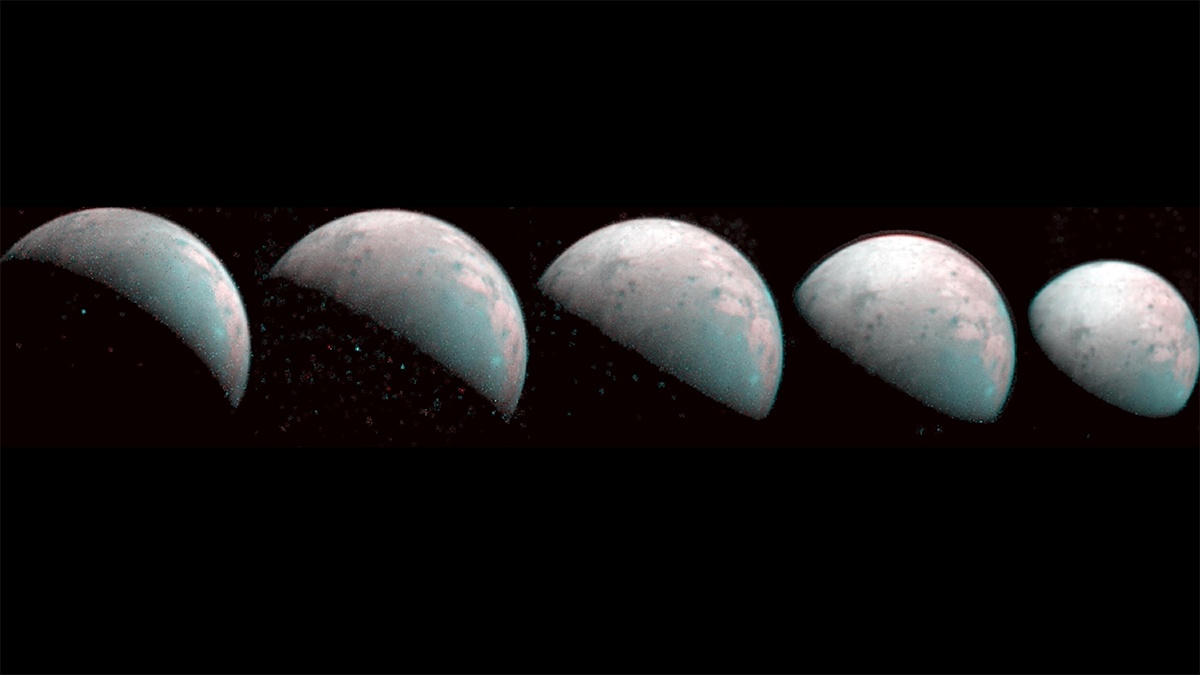On July 5, 2016, NASA’s Juno spacecraft arrived around Jupiter, becoming the second mission in history to study the gas giant from orbit – the last being the Galileo spacecraft, which orbited Jupiter from 1995 to 2003. Since then, the spacecraft has gathered data on Jupiter’s atmosphere, composition, gravity field, and magnetic field in the hopes of learning more about how the planet formed and evolved.
In addition, the spacecraft has gathered some of the most breathtaking images ever taken of Jupiter and its system of moons. In fact, as the spacecraft was making another approach towards Jupiter on December 26th, 2019, it managed to capture the first infrared images of the moon Ganymede’s northern polar region. These images will inform future missions to this satellite, which could host life beneath its icy mantle.
The images were captured by the Jovian Infrared Auroral Mapper (JIRAM) instrument, an imaging spectrometer contributed by the Italian Space Agency (ASI) designed to capture light emerging from the upper layers of Jupiter’s atmosphere, roughly 50 to 70 km (30 to 45 mi) beneath the cloud tops. Its primary purpose is to investigate the dynamics and chemistry of Jupiter’s auroral regions to determine their link to Jupiter’s magnetic field.
Knowing that Ganymede’s northern polar region would be within view of the spacecraft on Dec. 26th, 2019, during its flyby of Jupiter, the mission team adjusted Juno‘s orientation so that JIRAM and other instruments could be aimed toward the moon. During its closest approach to Ganymede, where it passed within 100,000 km (62,000 mi), JIRAM snapped 300 infrared images of the surface.
Already, these images have already led to some pretty significant scientific finds about Jupiter’s largest moon. As Alessandro Mura, a Juno co-investigator at the National Institute for Astrophysics in Rome, explained:
“The JIRAM data show the ice at and surrounding Ganymede’s north pole has been modified by the precipitation of plasma. It is a phenomenon that we have been able to learn about for the first time with Juno because we are able to see the north pole in its entirety.”
These findings could go a long way towards resolving the mystery of how Jupiter’s 79 known moons formed and evolved over time. In particular, they are helping scientists to address how Ganymede interacts with Jupiter’s powerful magnetic field, which is made even more interesting by the fact that Ganymede is the only moon in the Solar System known to generate its own magnetic field.

The presence of this field is why Ganymede (like Jupiter) experiences auroras in its atmosphere. On Earth, our magnetic field causes charged particles from the Sun (plasma) to be channeled towards the poles. This plasma interacts with gas particles in our upper atmosphere, resulting in ionization, excitation, and the visible release of energy (i.e. aurorae).
Much the same is true of Ganymede, where charged particles from Jupiter follow Ganymede’s magnetic field lines to the poles. However, unlike Earth, Ganymede has little atmosphere to speak of, which means the surface is constantly being bombarded by plasma from Jupiter’s magnetosphere. The bombardment has a dramatic effect on Ganymede’s surface, which is primarily composed of ice and amorphous around the poles.
As a result, the ice near Ganymede’s poles is amorphous and doesn’t have an ordered, crystalline structure. In addition, it has a different infrared signature than the crystalline ice found around the moon’s equatorial region. In this respect, the JIRAM instrument has demonstrated that it can be used to study Jupiter’s largest moons – Io, Europa, Ganymede, and Callisto, collectively known as the Galilean moons.
In addition, the data gathered by Juno and JIRAM will go a long way to informing the next mission to Ganymede. This would be the ESA’s JUpiter ICy moons Explorer (JUICE) mission, which is scheduled to launch in 2022 and will begin its 3 ½-year mission to explore Ganymede, Europa, and Callisto by 2030. It will also study Jupiter’s atmosphere and magnetosphere, picking up where Juno left off.
What data is obtained by this and other missions to the Jovian moons is expected to be very revealing. Not only will it help us to understand how our Solar System formed and how the planets could have migrated over time, it may also reveal the first indications of extraterrestrial life. With every examination, flyby, and image series captured around Jupiter, we are getting closer to determining if there is life beyond Earth.
Further Reading: NASA

